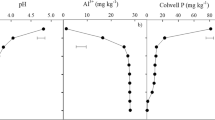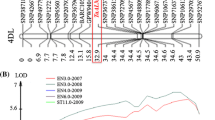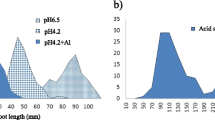Abstract
The aluminum (Al3+) tolerance of barley cultivars predominately from Brazil was compared to that of cultivars from other countries, wild barley accessions, and a transgenic line (L5) over-expressing TaALMT1, the major Al3+ tolerance gene from wheat. After screening conventional germplasm for Al3+ tolerance in hydroponics, 18 genotypes were further characterized in a short-term soil experiment. Among the Brazilian cultivars, Antarctica 01 and BRS Mariana showed the greatest relative root length (RRL) in acid soil. However, these cultivars were significantly less tolerant than the foreign cultivars Dayton (USA) and Murasakimochi (Japan) and the transgenic line L5 which out-performed all conventional genotypes. In long-term growth trials, the transgenic line produced the greatest relative root and relative shoot dry weight. Relative grain yield was greatest in the transgenic line and Dayton. All genotypes were also scored for two genetic markers linked to HvAACT1, the major Al3+ tolerance gene in barley. One marker detects a 1-kb insertion in the promoter that increases gene expression and leads to increased Al3+-activated citrate efflux from root apices. The other marker detects a 21-bp indel downstream of the coding region. The 1-kb insertion was only detected in Dayton and Murasakimochi that were the best performing cultivars among the non-transgenic germplasm. Interestingly, the Brazilian cultivars with an intermediate level of tolerance, Antarctica 01 and BRS Mariana, lacked the 1-kb insertion but had enhanced HvAACT1 expression compared to an Al3+-sensitive cultivar. No clear correlation was observed between Al3+ tolerance and the 21-bp indel marker in the short-term soil trials. We conclude that improved Al3+ tolerance in barley could be achieved by combining the best allele of HvAACT1 along with TaALMT1 as a transgene.




Similar content being viewed by others
Change history
13 February 2018
The original version of this article unfortunately contained a mistake. The online supplementary material (composed of Table S1, Fig. S1, and Fig. S2) was omitted in the published online version. The supplementary material is available in this version.
References
Aguilera JG, Minozzo JA, Barichello D, Fogaça CM, da Silva Jr JP, Consoli L, Pereira JF (2016) Alleles of organic acid transporter genes are highly correlated with wheat resistance to acidic soil in field conditions. Theor Appl Genet 129(7):1317–1331. https://doi.org/10.1007/s00122-016-2705-3
Baier AC, Somers DJ, Gusiafson JP (1995) Aluminium tolerance in wheat: correlating hydroponic evaluations with field and soil performances. Plant Breed 114(4):291–296. https://doi.org/10.1111/j.1439-0523.1995.tb01236.x
Baik BK, Ullrich SE (2008) Barley for food: characteristics, improvement, and renewed interest. J Cereal Sci 48(2):233–242. https://doi.org/10.1016/j.jcs.2008.02.002
Bian M, Waters I, Broughton S, Zhang XQ, Zhou M, Lance R, Sun D, Li C (2013) Development of gene-specific markers for acid soil/aluminium tolerance in barley (Hordeum vulgare L.) Mol Breeding 32(1):155–164. https://doi.org/10.1007/s11032-013-9859-3
Bian M, Jin X, Broughton S, Zhang XQ, Zhou G, Zhou M, Zhang G, Sun D, Li C (2015) A new allele of acid soil tolerance gene from a malting barley variety. BMC Genet 16(1):92. https://doi.org/10.1186/s12863-015-0254-4
Camargo CDO, Oliveira OD (1981) Tolerância de cultivares de trigo a diferentes níveis de alumínio em solução nutritiva e no solo. Bragantia 40(1):21–31. https://doi.org/10.1590/S0006-87051981000100003
de Mori C, Minella E (2012) Aspectos econômicos e conjunturais da cultura da cevada. Documentos online 139, Passo Fundo: Embrapa Trigo, 28 p
Delhaize E, Ryan PR, Hebb DM, Yamamoto Y, Sasaki T, Matsumoto H (2004) Engineering high-level aluminum tolerance in barley with the ALMT1 gene. Proc Natl Acad Sci U S A 101(42):15249–15254. https://doi.org/10.1073/pnas.0406258101
Delhaize E, Taylor P, Hocking PJ, Simpson RJ, Ryan PR, Richardson AE (2009) Transgenic barley (Hordeum vulgare L.) expressing the wheat aluminium resistance gene (TaALMT1) shows enhanced phosphorus nutrition and grain production when grown on an acid soil. Plant Biotechnol J 7(5):391–400. https://doi.org/10.1111/j.1467-7652.2009.00403.x
Doyle JJ, Doyle JL (1987) A rapid DNA isolation procedure for small quantities of fresh leaf material. Phytochem Bull 19:11–15
Ferreira JR, Pereira JF, Turchetto C, Minella E, Consoli L, Delatorre CA (2016) Assessment of genetic diversity in Brazilian barley using SSR markers. Genet Mol Biol 39(1):86–96. https://doi.org/10.1590/1678-4685-GMB-2015-0148
Ferreira JR, Faria BF, Comar M Jr, Delatorre CA, Minella E, Pereira JF (2017) Is a non-synonymous SNP in the HvAACT1 coding region associated with acid soil tolerance in barley? Genet Mol Biol 40(2):480–490. https://doi.org/10.1590/1678-4685-gmb-2016-0225
Flachowsky G, Schafft H, Meyer U (2012) Animal feeding studies for nutritional and safety assessments of feeds from genetically modified plants: a review. J Verbrauch Lebensm 7(3):179–194. https://doi.org/10.1007/s00003-012-0777-9
Foy CD (1983) The physiology of plant adaptation to mineral stress. Iowa State J Res 57:355–391
Fujii M, Yokosho K, Yamaji N, Saisho D, Yamane M, Takahashi H, Sato K, Nakazono M, Ma JF (2012) Acquisition of aluminium tolerance by modification of a single gene in barley. Nat Commun 3:713. https://doi.org/10.1038/ncomms1726
Furukawa J, Yamaji N, Wang H, Mitani N, Murata Y, Sato K, Katsuhara M, Takeda K, Ma JF (2007) An aluminum-activated citrate transporter in barley. Plant Cell Physiol 48(8):1081–1091. https://doi.org/10.1093/pcp/pcm091
Gustafsson JP (2010) Visual MINTEQ, version 3.0: a window version of MINTEQA2, version 4.0. Available at: http://www.lwr.kth.se/english/OurSoftware/Vminteq. 2010 (accessed in 13 Jan 2015)
Kinraide TB, Parker DR, Zobel RW (2005) Organic acid secretion as a mechanism of aluminium resistance: a model incorporating the root cortex, epidermis, and the external unstirred layer. J Exp Bot 56(417):1853–1865. https://doi.org/10.1093/jxb/eri175
Kopittke PM, McKenna BA, Karunakaran C, Dynes JJ, Arthur Z, Gianoncelli A, Kourousias G, Menzies NW, Ryan PR, Wang P, Green K, Blamey FPC (2017) Aluminum complexation with malate within the root apoplast differs between aluminum resistant and sensitive wheat lines. Front Plant Sci 8:1377. https://doi.org/10.3389/fpls.2017.01377
Ma JF, Chen ZC, Shen RF (2014) Molecular mechanisms of Al tolerance in gramineous plants. Plant Soil 381(1-2):1–12. https://doi.org/10.1007/s11104-014-2073-1
Ma Y, Li C, Ryan PR, Shabala S, You J, Liu J, Lui C, Zhou M (2016) A new allele for aluminium tolerance gene in barley (Hordeum vulgare L.) BMC Genomics 17(1):186. https://doi.org/10.1186/s12864-016-2551-3
Minella E, Sorrells ME (1997) Inheritance and chromosome location of Alp, a gene controlling aluminium tolerance in ‘Dayton’ barley. Plant Breed 116(5):465–469. https://doi.org/10.1111/j.1439-0523.1997.tb01032.x
Minella E, Sorrells ME (2002) Genetic analysis of aluminum tolerance in Brazilian barleys. Pesq Agropec Bras 37(8):1099–1103. https://doi.org/10.1590/S0100-204X2002000800007
Moroni JS, Sato K, Scott BJ, Conyers M, Read BJ, Fisher R, Poile G (2010) Novel barley (Hordeum vulgare L.) germplasm resistant to acidic soil. Crop Pasture Sci 61(7):540–553. https://doi.org/10.1071/CP10003
Mrízová K, Holasková E, Öz MT, Jiskrová E, Frébort I, Galuszka P (2014) Transgenic barley: a prospective tool for biotechnology and agriculture. Biotechnol Adv 32(1):137–157. https://doi.org/10.1016/j.biotechadv.2013.09.011
Narasimhamoorthy B, Blancaflor EB, Bouton JH, Payton ME, Sledge MK (2007) A comparison of hydroponics, soil, and root staining methods for evaluation of aluminum tolerance in Medicago truncatula (Barrel Medic) germplasm. Crop Sci 47(1):321–328. https://doi.org/10.2135/cropsci2006.03.0147
Navakode S, Weidner A, Varshney RK, Lohwasser U, Scholz U, Börner A (2009) A QTL analysis of aluminium tolerance in barley, using gene-based markers. Cereal Res Commun 37(4):531–540. https://doi.org/10.1556/CRC.37.2009.4.6
Nevo E, Fu YB, Pavlicek T, Khalifa S, Tavasi M, Beiles A (2012) Evolution of wild cereals during 28 years of global warming in Israel. Proc Natl Acad Sci U S A 109(9):3412–3415. https://doi.org/10.1073/pnas.1121411109
Paynter BH (2014) Litmus barley improved tolerance to soil acidity. GRDC Update: Grains Research and Development Corporation (https://grdc.com.au/Research-and-Development/GRDC-Update-Papers/2014/05/Litmus-barley-improved-tolerance-to-soil-acidity). Accessed 09 Nov 2016
Sasaki T, Yamamoto Y, Ezaki B, Katsuhara M, Ahn SJ, Ryan PR, Delhaize E, Matsumoto H (2004) A wheat gene encoding an aluminum-activated malate transporter. Plant J 37(5):645–653. https://doi.org/10.1111/j.1365-313X.2003.01991.x
Soto-Cerda BJ, Penaloza EH, Montenegro AB, Rupayan AR, Gallardo MH, Salvo-Garrido H (2013) An efficient marker-assisted backcrossing strategy for enhancing barley (Hordeum vulgare L.) production under acidity and aluminium toxicity. Mol Breeding 31(4):855–866. https://doi.org/10.1007/s11032-013-9839-7
Spehar CR, Souza LAC (2006) Selection for aluminum tolerance in tropical soybeans. Pesq Agropec Trop 36:1–6
Villagarcia MR, Carter TE, Rufty TW, Niewoehner AS, Jennette MW, Arrellano C (2001) Genotypic rankings for aluminum tolerance of soybean roots grown in hydroponics and sand culture. Crop Sci 41(5):1499–1507. https://doi.org/10.2135/cropsci2001.4151499x
Voss M, Sousa CNA, Baier AC, Nascimento-Junior A, Boff T (2006) Método de avaliação de tolerância à toxidez de alumínio em trigo, em condições de hidroponia, na Embrapa Trigo. Documentos Online 67, Passo Fundo: Embrapa Trigo, 16 p
Wang J, Raman H, Zhou M, Ryan PR, Delhaize E, Hebb DM, Coombes N, Mendham N (2007) High-resolution mapping of the Alp locus and identification of a candidate gene HvMATE controlling aluminium tolerance in barley (Hordeum vulgare L.) Theor Appl Genet 115(2):265–276. https://doi.org/10.1007/s00122-007-0562-9
Zhao Z, Ma JF, Sato K, Takeda K (2003) Differential Al resistance and citrate secretion in barley (Hordeum vulgare L.) Planta 217(5):794–800. https://doi.org/10.1007/s00425-003-1043-2
Zhou G, Delhaize E, Zhou M, Ryan PR (2013) The barley MATE gene, HvAACT1, increases citrate efflux and Al3+ tolerance when expressed in wheat and barley. Ann Bot 112(3):603–612. https://doi.org/10.1093/aob/mct135
Zhou G, Pereira JF, Delhaize E, Zhou M, Magalhaes JV, Ryan PR (2014) Enhancing the aluminium tolerance of barley by expressing the citrate transporter genes SbMATE and FRD3. J Exp Bot 65(9):2381–2390. https://doi.org/10.1093/jxb/eru121
Acknowledgments
We are thankful to Ambev (Companhia de Bebidas das Américas), Agrária, CNPq (Conselho Nacional de Desenvolvimento Científico e Tecnológico), and Embrapa (Empresa Brasileira de Pesquisa Agropecuária) for the financial support. We thank Dr. Sirio Wietholter and his team (Embrapa Trigo) for the soil analysis and Bárbara Bremm, Guilherme Paim Fraga, and Helen Estima Lazzari (Universidade Federal do Rio Grande do Sul) for helping in hydroponics experiments.
Author information
Authors and Affiliations
Corresponding author
Additional information
A correction to this article is available online at https://doi.org/10.1007/s11032-018-0786-1.
Rights and permissions
About this article
Cite this article
Ferreira, J.R., Minella, E., Delatorre, C.A. et al. Conventional and transgenic strategies to enhance the acid soil tolerance of barley. Mol Breeding 38, 12 (2018). https://doi.org/10.1007/s11032-017-0769-7
Received:
Accepted:
Published:
DOI: https://doi.org/10.1007/s11032-017-0769-7




